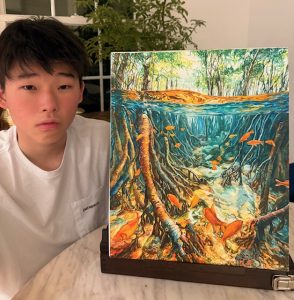Gender-Bending Fashion in the 21st Century
January 28, 2020
The end of a year often signals a time of reflection—in 2019, there were protests regarding climate change, proposed legislation on gun control, and more diverse representation in the film industry. In addition to all these significant societal strides, there was the challenging of gender norms within the realm of fashion. In 2019, from March 21 to August 25, the Museum of Fine Arts in Boston, Massachusetts held a major exhibition, appropriately named Gender Bending Fashion, that explored the relationship between fashion and gender.
The exhibition featured contemporary designs that challenged gender stereotypes alongside traditional garments from the 20th-century. In addition to the clothing, the exhibition included photographs that depicted a history of brave individuals who sought to challenge the social norms that strictly bifurcated men’s fashion and women’s fashion in the past 100 years. This exhibition was unique and different from other art exhibitions hosted by the museum because not only were styles and trends documented, but the garments and the stories that accompanied them spoke about shifts in societal views regarding LGBTQIA+ rights as well as racial and gender equality.
Furthermore, as a public engagement project, the organizers of the event sought to create a discussion surrounding gender issues in the fashion industry. Visitors were encouraged to share their thoughts and responses to the exhibition through comment cards as well as through social media. This lively discussion on the internet is present on the Instagram platform and is searchable through the hashtag, “GenderBendingFashion.” This feature within the exhibition itself made the whole experience interactive. Nonetheless, this conversation is also alive and well in the halls of the Bergen County Academies (BCA). The students at BCA are diverse in background and views and are also no strangers to lively debates regarding a myriad of modern topics and issues.
As a part of Generation Z, the demographic cohort consisting of those born between the years of 1995 and 2015, the BCA student community is clearly representative of the spectrum of views of the youth today. These views are a progression and deviation from the views of prior generations, the Baby Boomers, Generation X-ers, and Millennials. When asked how the views of Generation Z may differ from that of older generations, ABFIB junior, Kaylyn Lu responded: “They [the views] differ a lot because a lot of older generations typically have very set views on what men should wear and what women should wear. For example, if my grandparents see my little cousin, who is a boy, wear anything that’s not traditionally masculine, then they will get very angry.” These set views and stereotypes, mainly established in the early-to-mid-20th century, have remained with the older generations to this day, with many of these elderly unable to adapt and shift to changing societal views.
Vivek Rajani, a junior in AMST, offered an explanation as to why our views may be more flexible in comparison to the set views of older generations: “I think obviously with the new generation [Generation Z], we’re exposed to a lot more: different cultures, different sexualities, and different ways of life. So, we’re a bit more open to understanding how different people dress compared to older generations.” Increased exposure to different people in general on a multitude of media platforms have allowed Generation Z to be accepting of actions that may have been seen as prude and indecent in earlier times.
With regards to the move towards gender-neutral fashion, such as utilitarian fashion and work-wear, as seen on runways, Kaylyn provided an explanation to these changes: “Since these companies are businesses, they want to gear their product more towards what society’s leaning towards at the time. So since there is societal shift right now towards gender-neutral clothing, they will want to accommodate that so that they can maximize their profit.” Since society’s views, or more so the views of Generation Z, are shifting towards the tolerance and acceptance of gender neutral fashion, we desire to purchase more items that adhere to these trends.
Vivek offered another possible explanation for such an acceptance and inclination towards more androgenous pieces of clothing: “I think that the culture [today] is that people don’t want to offend anyone. Since there are now so many varieties of sexualities and ways of perceiving the world, people don’t want to offend [other] people and categorize them into groups.” This explanation suggests that younger generation has developed into a more accepting, tolerant, and open-minded group of people in contrast to the older generations.
These changes in fashion are demonstrative of changes in women’s changing roles within society. Kaylyn believes that “the shift towards more gender-neutral clothing shows that there is less disparity now, at least in our perception of men versus women; traditionally, women’s clothing have either been more conservative in certain culture or explicit sexual in other cultures, so this shift towards more gender neutral means that it doesn’t really matter who you are, man or woman, and what you’re wearing—gender is becoming less and less important.”
This decreased emphasis on associating gender with a certain style of clothing is evident on the TV show, RuPaul’s Drag Race. According to Kaylyn, “there’s a lot of attention going towards RuPaul’s Drag Race, which is very popular among our generation, . . . because people are now willing to be public about how they dress, and they’re not receiving criticism, but praise.” The youth of society today are now more supportive and accepting of those who are different, including those who choose to dress differently.
Vivek added that he believes that this shift in fashion is a “good step” because “allowing them [women] to purchase men’s clothing” and making people “see them [women wearing men’s clothing] as normal signifies a huge step in gender equality.”
The gender-bending fashion exhibit at the Museum of Fine Arts mirrors a change in societal views and marks a shift towards and era of acceptance and tolerance. The students of the Bergen County Academies are generally aligned with this transition towards supporting the differences and idiosyncrasies of each individual. BCA is an accepting environment because of the diverse background of the students. Ultimately, in the 21st century, our fashion choices and what we wear no longer are indicators of our gender and who we are—we are who we choose to be, regardless of whether or not that is reflected in the pieces of clothing we wear.




